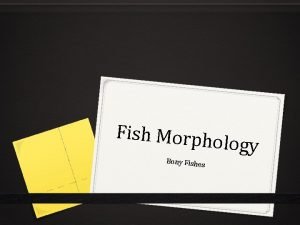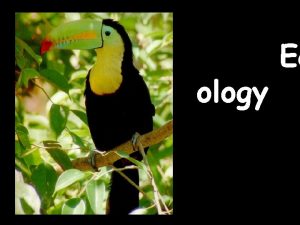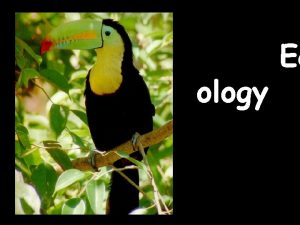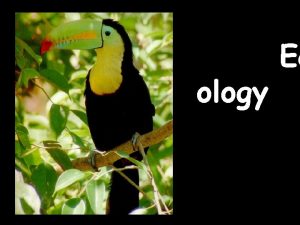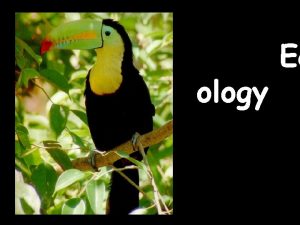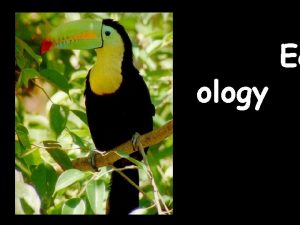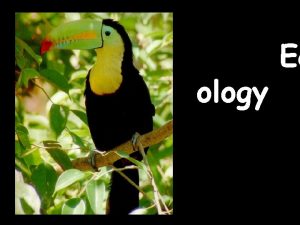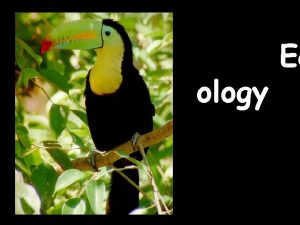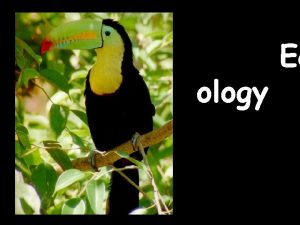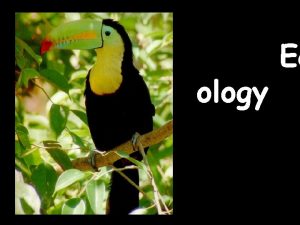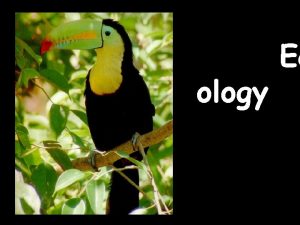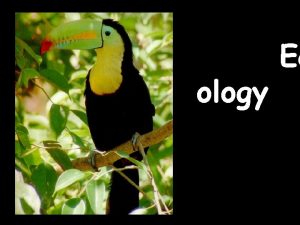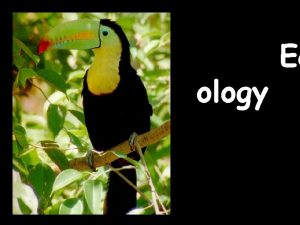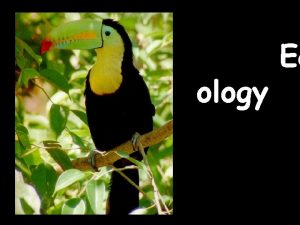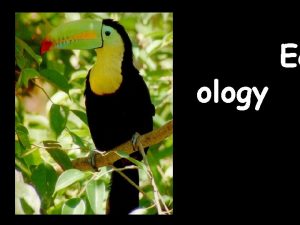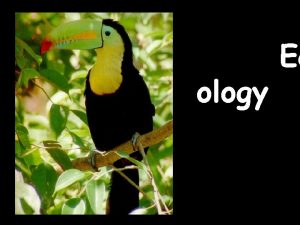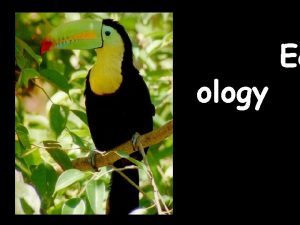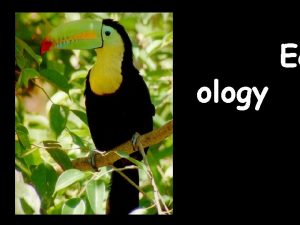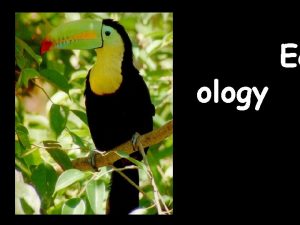ology Ec WHAT IS ECOLOGY Ecology the scientific






















- Slides: 22

ology Ec

WHAT IS ECOLOGY? Ecology- the scientific study of interactions between organisms and their environments, focusing on energy transfer Ecology is a science of relationships

WHAT DO YOU MEAN BY ENVIRONMENT? The environment is made up of two factors: • Biotic factors- all living organisms inhabiting the Earth • Abiotic factors- nonliving parts of the environment (i. e. temperature, soil, light, moisture, air currents)

Biotic—living factors that influence an ecosystem Abiotic—non-living factors that influence an ecosystem

Ecological Interactions between organisms Competition—when two organisms of the same or different species attempt to use an ecological resource in the same place at the same time. Biotic/Biotic interactions Ex: food, water, shelter

Monkeys compete with each other and other animals for food. INTERSPECIFIC COMPETITION Rams compete with each other for mates. INTRASPECIFIC COMPETITION

Until Americans introduced gray squirrels into parts of England in the early 20 th century, red squirrels had been the only species of squirrel in the country. The gray squirrels were larger and bred faster and successfully competed for resources. Within a couple years of overlap in an area, the red squirrels disappeared.

Niche—the ecological niche involves both the place where an organism lives and the roles that an organism has in its habitat. Biotic/Abiotic interactions Example: The ecological niche of a sunflower growing in the backyard includes absorbing light, water and nutrients (for photosynthesis), providing shelter and food for other organisms (e. g. bees, ants, etc. ), and giving off oxygen into the atmosphere.

The ecological niche of an organism depends not only on where it lives but also on what it does. By analogy, it may be said that the habitat is the organism’s “address”, and the niche is its “profession”, biologically speaking. Worm’s Niche “Address”—Soil, Ground, etc. “Profession”– Mix-up soil

Dealing with changes in environmental conditions Conformers: organisms that do not regulate their internal conditions; they change as their environment changes Regulators: organisms that use energy to control some of their internal conditions

Habitat vs. Niche - the role a species plays in a community; its total way of life Habitat- the place in which an organism lives out its life

Habitat vs. Niche Each organism is able to survive within a limited range of environmental conditions.

Habitat vs. Niche A niche is determined by the tolerance limitations of an organism, or a limiting factor. Limiting factor- any biotic or abiotic factor that restricts the existence of organisms in a specific environment.

Habitat vs. Niche Examples of limiting factors - • Amount of water • Amount of food • Temperature • Amount of space • Availability of mates

Habitat vs. Niche • Generalists are species with broad niches • Specialists are species with narrow niches

Biosphere Biome Ecosystem Community Population Organism

Biosphere - life supporting portions of Earth composed of air, land, fresh water, and salt water. • The highest level of organization

Biome – Large areas of land with similar abiotic and biotic factors

Ecosystem - populations in a community and the abiotic factors with which they interact (ex. marine, terrestrial)

Community - several interacting populations that inhabit a common environment and are interdependent.

POPULATION ü a group of organisms of one species living in the same place at the same time that interbreed üProduce fertile offspring üCompete with each other for resources (food, mates, shelter, etc. )

Organism - any unicellular or multicellular form exhibiting all of the characteristics of life, an individual. • The lowest level of organization
 Root word ology
Root word ology Snakeü
Snakeü My ology
My ology How is a scientific law different from a scientific theory?
How is a scientific law different from a scientific theory? Information gathered during an experiment
Information gathered during an experiment Công thức tính thế năng
Công thức tính thế năng Khi nào hổ mẹ dạy hổ con săn mồi
Khi nào hổ mẹ dạy hổ con săn mồi Thế nào là mạng điện lắp đặt kiểu nổi
Thế nào là mạng điện lắp đặt kiểu nổi Dạng đột biến một nhiễm là
Dạng đột biến một nhiễm là Các châu lục và đại dương trên thế giới
Các châu lục và đại dương trên thế giới Thế nào là sự mỏi cơ
Thế nào là sự mỏi cơ Bổ thể
Bổ thể Phản ứng thế ankan
Phản ứng thế ankan Thiếu nhi thế giới liên hoan
Thiếu nhi thế giới liên hoan Hát lên người ơi alleluia
Hát lên người ơi alleluia điện thế nghỉ
điện thế nghỉ Một số thể thơ truyền thống
Một số thể thơ truyền thống Trời xanh đây là của chúng ta thể thơ
Trời xanh đây là của chúng ta thể thơ Sơ đồ cơ thể người
Sơ đồ cơ thể người Số nguyên tố là gì
Số nguyên tố là gì Tỉ lệ cơ thể trẻ em
Tỉ lệ cơ thể trẻ em Phối cảnh
Phối cảnh đặc điểm cơ thể của người tối cổ
đặc điểm cơ thể của người tối cổ

